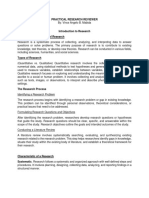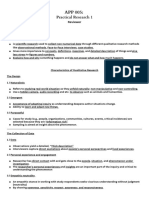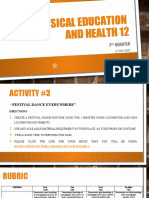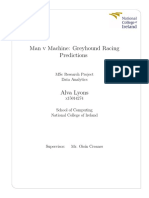Qualitative & Quantitative
Qualitative & Quantitative
Uploaded by
ERICKA GRACE DA SILVACopyright:
Available Formats
Qualitative & Quantitative
Qualitative & Quantitative
Uploaded by
ERICKA GRACE DA SILVAOriginal Title
Copyright
Available Formats
Share this document
Did you find this document useful?
Is this content inappropriate?
Copyright:
Available Formats
Qualitative & Quantitative
Qualitative & Quantitative
Uploaded by
ERICKA GRACE DA SILVACopyright:
Available Formats
QUALITATIVE
Qualitative research is the process of collecting, analyzing, and interpreting
non-numerical data, such as language. Qualitative research can be used to
understand how an individual subjectively perceives and gives meaning to
their social reality.
Qualitative data is defined as non-numerical data, such as text, video,
photographs, or audio recordings. This type of data can be collected using
diary accounts or in-depth interviews and analyzed using grounded theory
or thematic analysis.
Qualitative research is multimethod in focus, involving an interpretive,
naturalistic approach to its subject matter. This means that qualitative
researchers study things in their natural settings, attempting to make sense
of, or interpret, phenomena in terms of the meanings people bring to them.
Exploring the experience of participants is known as a phenomenological
approach
The aim of qualitative research is to understand the social reality of
individuals, groups, and cultures as nearly as possible as its participants
feel it or live it. Thus, people and groups, are studied in their natural
setting.
Research following a qualitative approach is exploratory and seeks to
explain ‘how’ and ‘why’ a particular phenomenon, or behavior, operates as
it does in a particular context. It can be used to generate hypotheses and
theory from the data.
Methods (used to obtain qualitative data)
There are different types of qualitative research methods including diary
accounts, in-depth interviews, documents, focus groups, case study
research, and ethnography.
(Unstructured interviews do not use any set questions, instead, the
interviewer asks open-ended questions based on a specific research topic and will
try to let the interview flow like a natural conversation. The interviewer modifies
his or her questions to suit the candidate's specific experiences. Unstructured
interviews are sometimes referred to as ‘discovery interviews’ and are more like a
‘guided conservation’ than a strict structured interview. They are sometimes
called informal interviews.)
The results of qualitative methods provide a deep understanding of how
people perceive their social realities, and in consequence, how they act
within the social world.
The researcher has several methods for collecting empirical materials,
ranging from the interview to direct observation, to the analysis of
artifacts, documents, and cultural records, to the use of visual materials or
personal experience.
A good example of a qualitative research method would be unstructured
interviews which generate qualitative data using open questions. This
allows the respondent to talk in some depth, choosing their own words.
This helps the researcher develop a real sense of a person’s understanding
of a situation.
Data Analysis
Qualitative research is endlessly creative and interpretive. The researcher
does not just leave the field with mountains of empirical data and then
easily write up his or her findings.
Qualitative interpretations are constructed, and various techniques can be
used to make sense of the data, such as content analysis, grounded
theory (Glaser & Strauss, 1967), thematic analysis (Braun & Clarke, 2006)
or discourse analysis.
(Content analysis is a method that may be used with either qualitative
or quantitative data; furthermore, it may be used in an inductive or deductive
way. inductive reasoning aims at developing a theory while deductive reasoning
aims at testing an existing theory. Inductive reasoning moves from specific
observations to broad generalizations, and deductive reasoning the other way
around.)
Key Features
Qualitative researchers want those who are studied to speak for
themselves, to provide their perspectives in words and other actions.
Therefore, qualitative research is an interactive process in which the
persons studied teach the researcher about their lives. The qualitative
researcher is an integral part of the data, without the active participation of
the researcher, no data exists.
The design of the study evolves during the research and can be adjusted or
changed as it progresses.
For the qualitative researcher, there is no single reality, it is subjective and
exist only in reference to the observer.
Qualitative research uses a descriptive, narrative style; this research might
be of particular benefit to the practitioner as she or he could turn to
qualitative reports to examine forms of knowledge that might otherwise be
unavailable, thereby gaining new insight.
QUANTITATIVE
Quantitative research involves the process of objectively collecting and
analyzing numerical data to describe, predict, or control variables of
interest.
The goals of quantitative research are to test causal relationships between
variables, make predictions, and generalize results to wider populations.
Quantitative researchers aim to establish general laws of behavior and
phenomenon across different settings/contexts. Research is used to test a
theory and ultimately support or reject it.
Methods (used to obtain quantitative data)
Experiments typically yield quantitative data, as they are concerned with
measuring things. However, other research methods, such as controlled
observations and questionnaires can produce both quantitative
information.
For example, a rating scale or closed questions on a questionnaire would
generate quantitative data as these produce either numerical data or data
that can be put into categories (e.g., “yes,” “no” answers).
Experimental methods limit the possible ways in which a research
participant can react to and express appropriate social behavior.
Data Analysis
Statistics help us turn quantitative data into useful information to help
with decision making. We can use statistics to summarize our data,
describing patterns, relationships, and connections. Statistics can be
descriptive or inferential.
Descriptive statistics help us to summarize our data whereas inferential
statistics are used to identify statistically significant differences between
groups of data (such as intervention and control groups in a randomized
control study).
Key Features
The research aims for objectivity (i.e., without bias), and is separated from
the data.
The design of the study is determined before it begins.
For the quantitative researcher reality is objective and exist separately to
the researcher and is capable of being seen by anyone.
Research is used to test a theory and ultimately support or reject it.
Context: Quantitative experiments do not take place in natural settings. In
addition, they do not allow participants to explain their choices, or the
meaning of the questions may have for those participants.
Researcher expertise: Poor knowledge of the application of statistical
analysis may negatively affect analysis and subsequent interpretation.
Variability of data quantity: large sample sizes are needed for more
accurate analysis. Small scale quantitative studies may be less reliable
because of the low quantity of data. This also affects the ability to
generalize study findings to wider populations.
Characteristic of QUALITATIVE RESEARCH
1. Real-world Setting
The real-world setting is the first characteristic of qualitative
research. In qualitative research methods like observation
method, ethnographic research, focus group, one-to-one interviews,
the behavior of the participants of study is observed, and the
conclusion is drawn based on their answers and their behavior. For
example, A teacher will conduct qualitative research if he wants to
know about the reason for the declining performance of students in
the class. Qualitative research is conducted in natural settings to get
real information.
2. Researcher Plays an important role
A researcher is a person who performs qualitative research.
Qualitative research can be conducted by a group of people or by
an individual. The purpose of a researcher is essential in qualitative
research. The researcher of qualitative research is responsible for
choosing the research method and for planning to conduct effective
research.
The researcher is also responsible for participating in the study to
make the right observations. He participates in the research and
engages the participants in the study. He also explains the procedure
of research to the participants and answers their queries.
3. Different Research methods
Another vital characteristic of qualitative research method is the
various methods of research. For example, focus group, face-to-face
interview, observation research methods, case study, content
analysis, ethnography, phenomenology, ground theory, group
discussions.
Each qualitative research method has different significance and is
used for different scenarios and research situations. Sometimes,
researchers make the use of more than one qualitative research
method to obtain the accurate output. Research methods like a case
study and Content analysis are also used to compare the results
of quantitative research.
4. Complex reasoning
An essential characteristic of the qualitative research method is that
it is beneficial for complex reasoning. Sometimes, there are search
situations which are required to have complex rationale to get the
right results rather than direct statistical answers.
For example, if a restaurant owner wants to know about what kind of
entertainment people prefer at different hours of the day and why
then he is required to adopt one of the qualitative research methods
to understand the psychology of customers behind the choice of their
entertainment.
5. Flexible
Qualitative research is flexible. It can change at any stage of the
research and based on the change; the course of research might also
get changed. Therefore, qualitative research is used in such a
scenario where the flexible nature of research is acceptable.
6. Reflexivity
In qualitative research, the researchers share everything about
themselves like their background and their purpose of research with
the participants. Reflexivity also makes them participate in the
research openly and willingly.
7. Emergent Design
A unique characteristic of qualitative research is its new design. That
means a qualitative research method can remain the same as decided
by the researcher at the beginning of the research process. The
research process changes at every stage of the research. Sometimes,
change in the research process changes when the researcher starts
collecting data for the research problem.
This can result in the difference in the methods being used for the
research and sometimes, the research problem is altered and results
in a completely new research problem. Because of this, the
researcher is required to be ready to change in the whole research
process at any time or phase of the research.
The primary purpose of qualitative research methods is not to
determine a quantitative answer but to be able to establish an
understanding of the problem and to find out in detail about it.
QUALITATIVE RESEARCH APPROACHES
A qualitative “approach” is a general way of thinking about conducting
qualitative research. It describes, either explicitly or implicitly, the purpose
of the qualitative research, the role of the researcher(s), the stages of
research, and the method of data analysis. here, four of the major
qualitative approaches are introduced.
1. Ethnography
The ethnographic approach to qualitative research comes largely from the
field of anthropology. The emphasis in ethnography is on studying an
entire culture. Originally, the idea of a culture was tied to the notion of
ethnicity and geographic location (e.g., the culture of the Trobriand
Islands), but it has been broadened to include virtually any group or
organization. That is, we can study the “culture” of a business or defined
group (e.g., a Rotary club).
Ethnography is an extremely broad area with a great variety of
practitioners and methods. However, the most common ethnographic
approach is participant observation as a part of field research. The
ethnographer becomes immersed in the culture as an active participant
and records extensive field notes. As in grounded theory, there is no preset
limiting of what will be observed and no real ending point in an
ethnographic study.
2. Phenomenology
Phenomenology is sometimes considered a philosophical perspective
as well as an approach to qualitative methodology. It has a long
history in several social research disciplines including psychology,
sociology, and social work. Phenomenology is a school of thought
that emphasizes a focus on people’s subjective experiences and
interpretations of the world. That is, the phenomenologist wants to
understand how the world appears to others.
3. Field Research
Field research can also be considered either a broad approach to
qualitative research or a method of gathering qualitative data. the
essential idea is that the researcher goes “into the field” to observe
the phenomenon in its natural state or in situ. As such, it is probably
most related to the method of participant observation. The field
researcher typically takes extensive field notes which are
subsequently coded and analyzed in a variety of ways.
4. Grounded Theory
Grounded theory is a complex iterative process. The research begins with the
raising of generative questions which help to guide the research but are not
intended to be either static or confining. As the researcher begins to gather
data, core theoretical concept(s) are identified. Tentative linkages are developed
between the theoretical core concepts and the data. This early phase of the
research tends to be very open and can take months. Later on, the researcher is
more engaged in verification and summary. The effort tends to evolve toward
one core category that is central.
There are several key analytic strategies:
Coding is a process for both categorizing qualitative data and for
describing the implications and details of these categories. Initially one
does open coding, considering the data in minute detail while developing
some initial categories. Later, one moves to more selective coding where
one systematically code with respect to a core concept.
Memoing is a process for recording the thoughts and ideas of the
researcher as they evolve throughout the study. You might think of
memoing as extensive marginal notes and comments. Again, early in the
process these memos tend to be very open while later they tend to
increasingly focus in on the core concept.
Integrative diagrams and sessions are used to pull all the detail
together, to help make sense of the data with respect to the emerging
theory. The diagrams can be any form of graphic that is useful at that point
in theory development. They might be concept maps or directed graphs or
even simple cartoons that can act as summarizing devices. This integrative
work is best done in group sessions where different members of the
research team can interact and share ideas to increase insight.
Eventually one approaches conceptually dense theory as new observation leads
to new linkages which lead to revisions in the theory and more data collection.
The core concept or category is identified and fleshed out in detail.
You might also like
- Qualitative RafuDocument44 pagesQualitative Rafually jumanneNo ratings yet
- Qualitative Research DesignDocument35 pagesQualitative Research Designkimemia100% (4)
- VDA Volume 5 en Grafiken DownloadDocument31 pagesVDA Volume 5 en Grafiken Downloadedgarinho753642100% (2)
- Science Fair ProjectDocument11 pagesScience Fair Projectapi-570957779No ratings yet
- Hinges - Google SearchDocument1 pageHinges - Google SearchMaxwell DavorNo ratings yet
- What's The Difference Between Qualitative and Quantitative Research?Document9 pagesWhat's The Difference Between Qualitative and Quantitative Research?MaryJoyceRamosNo ratings yet
- DISCUSSION 2 Qualitative ResearchDocument34 pagesDISCUSSION 2 Qualitative ResearchDave BanquerigoNo ratings yet
- Qualitative vs. Quantitative ResearchDocument6 pagesQualitative vs. Quantitative ResearchChristia Abdel HayNo ratings yet
- Characteristics of Qualitative ResearchDocument24 pagesCharacteristics of Qualitative ResearchTahirullah JanNo ratings yet
- Practical Research ReviewerDocument8 pagesPractical Research Reviewervinceangelo.mabidaNo ratings yet
- Hossein Tavakoli: Research Method 2012 TehranDocument9 pagesHossein Tavakoli: Research Method 2012 TehranFaith FulNo ratings yet
- Qualitative Vs Quantitative ResearchDocument67 pagesQualitative Vs Quantitative ResearchAlano Jo100% (3)
- Characteristics of Qualitative ResearchDocument5 pagesCharacteristics of Qualitative Researchshabnam100% (1)
- Qualitative Research ForDocument46 pagesQualitative Research ForThanavathi100% (1)
- 3Q Activity 2Document2 pages3Q Activity 2YZAH LORRAINE DELA CRUZNo ratings yet
- Qualitative ResearchDocument17 pagesQualitative ResearchNouvie AguirreNo ratings yet
- Chapter 3 Quantitative Qualitative Research DesignDocument5 pagesChapter 3 Quantitative Qualitative Research DesignBenjie HallardaNo ratings yet
- Comparative Research ParadigmsDocument10 pagesComparative Research Paradigmstozion01No ratings yet
- Approaches EtcDocument10 pagesApproaches Etcsharvari solapureNo ratings yet
- Midterm Examination in Qualitative ResearchDocument8 pagesMidterm Examination in Qualitative ResearchJohnny JohnnyNo ratings yet
- Qualitative Research DesignsDocument6 pagesQualitative Research DesignsBhawna JoshiNo ratings yet
- Metholodogies, Characteristics, Approaches of Qualitative and Quantitative ResearchDocument9 pagesMetholodogies, Characteristics, Approaches of Qualitative and Quantitative ResearchLea Victoria PronuevoNo ratings yet
- 06 Critical Appraisal of Qualitative Research 2Document27 pages06 Critical Appraisal of Qualitative Research 2Nayomi YviNo ratings yet
- Practical Research 1 SlideshowDocument96 pagesPractical Research 1 SlideshowGresel GabawanNo ratings yet
- PR1 L4Document43 pagesPR1 L4Garie PanganibanNo ratings yet
- Att HKRDJafe4Y16-3PEE0uYU997mAA3PU73ec5CZA6IJRwDocument9 pagesAtt HKRDJafe4Y16-3PEE0uYU997mAA3PU73ec5CZA6IJRwKhan TalkNo ratings yet
- Quantitative Research Thus Reduces SubjectivityDocument10 pagesQuantitative Research Thus Reduces SubjectivityShukri MohaNo ratings yet
- Qualitative Research An IntroductionDocument43 pagesQualitative Research An Introductionmary car fabularumNo ratings yet
- What Justification Needed For A Research Method ChoiceDocument8 pagesWhat Justification Needed For A Research Method ChoiceMasni HasimNo ratings yet
- Unit 2 Qualitative Research 1. The Nature of Qualitative ResearchDocument77 pagesUnit 2 Qualitative Research 1. The Nature of Qualitative ResearchArchana PokharelNo ratings yet
- EL 16 Module 7Document15 pagesEL 16 Module 7vncedabsNo ratings yet
- Assignment 1-2 - Quantitative and Qualitative ResearchDocument11 pagesAssignment 1-2 - Quantitative and Qualitative ResearchBenedict Arman TanchaucoNo ratings yet
- Research MethadologyDocument30 pagesResearch MethadologyshahzaibziamNo ratings yet
- 6 - Designing Qualitative ResearchDocument39 pages6 - Designing Qualitative ResearchawokegoshiNo ratings yet
- Qualitative ResearchDocument16 pagesQualitative ResearchTirti RayNo ratings yet
- C5 Qualitative Research Methodology - 18032023Document27 pagesC5 Qualitative Research Methodology - 18032023Nanthakumar SubramanianNo ratings yet
- Q3 Week1 Part2Document35 pagesQ3 Week1 Part2Mary Rose AlegriaNo ratings yet
- Difference Between Qualitative and Quantitative Literature ReviewDocument4 pagesDifference Between Qualitative and Quantitative Literature ReviewaflshvifmNo ratings yet
- What Justification Needed For A Research Method ChoiceDocument7 pagesWhat Justification Needed For A Research Method ChoiceMasni HasimNo ratings yet
- Note For Mid 1Document19 pagesNote For Mid 1Tafhimul IslamNo ratings yet
- Question # 1: Grounded TheoryDocument16 pagesQuestion # 1: Grounded TheoryM.TalhaNo ratings yet
- pr1 ReviewerDocument3 pagespr1 ReviewerkathreenezyanaNo ratings yet
- Ce - ch14 Qualitative Research1Document16 pagesCe - ch14 Qualitative Research1faul ahmadNo ratings yet
- Research II Lesson 2Document21 pagesResearch II Lesson 2Zarah Leeann P. ZafraNo ratings yet
- Difference Between Quantitative and Qualitative Research in The Perspective of The Research ParadigmDocument3 pagesDifference Between Quantitative and Qualitative Research in The Perspective of The Research ParadigmQamar Zaman MalikNo ratings yet
- ALICEDocument6 pagesALICESOMOSCONo ratings yet
- Advanced Research Methodology 2Document18 pagesAdvanced Research Methodology 2Raquibul Hassan100% (1)
- Marketing ResearchDocument19 pagesMarketing Researchkiran rajNo ratings yet
- ResearchDocument2 pagesResearchRoanmae DelosangelesNo ratings yet
- PR1 Lesson 3Document7 pagesPR1 Lesson 3Ruel AcostaNo ratings yet
- PR2 Lesson 1Document5 pagesPR2 Lesson 1Marcco Juan MarccoNo ratings yet
- Qualitative Research in NursingDocument98 pagesQualitative Research in NursingMark Anthony Flores75% (8)
- App 005: Practical Research 1Document10 pagesApp 005: Practical Research 1ayannazxiNo ratings yet
- UNIT TWO - Types of Research, Quantitative ResearchDocument22 pagesUNIT TWO - Types of Research, Quantitative ResearchSerawit DejeneNo ratings yet
- Chapter 15Document6 pagesChapter 15Annie FrecklesNo ratings yet
- Methodology BSDocument11 pagesMethodology BSliyanayanaa96No ratings yet
- QuanDocument6 pagesQuanstrongzhongliNo ratings yet
- 8 Types of Qualitative ResearchDocument3 pages8 Types of Qualitative ResearchhinaNo ratings yet
- Qualitative ResearchDocument37 pagesQualitative Researchsandhya67% (3)
- Types of ResearchDocument22 pagesTypes of Researchamanahlali28No ratings yet
- PR 1 Quantitative and QualitatativeDocument22 pagesPR 1 Quantitative and QualitatativeJasmin SerranoNo ratings yet
- Physical Education and Health 12: 2 QuarterDocument5 pagesPhysical Education and Health 12: 2 QuarterERICKA GRACE DA SILVANo ratings yet
- By: Da Silva, Ericka Grace T. Dela Cruz, Janelle T. Delgado, Rayzon D. Exconde, Areeya Charlee B. Faderanga, Gladys LDocument10 pagesBy: Da Silva, Ericka Grace T. Dela Cruz, Janelle T. Delgado, Rayzon D. Exconde, Areeya Charlee B. Faderanga, Gladys LERICKA GRACE DA SILVANo ratings yet
- Notes To FS Year 1 Year 2 Year 3 Note 1: Service RevenueDocument4 pagesNotes To FS Year 1 Year 2 Year 3 Note 1: Service RevenueERICKA GRACE DA SILVANo ratings yet
- Act. #2Document2 pagesAct. #2ERICKA GRACE DA SILVANo ratings yet
- Bus Ethics - Asynch No 4Document1 pageBus Ethics - Asynch No 4ERICKA GRACE DA SILVANo ratings yet
- Perception of Small Business Owners Regarding The Effectiveness of Using Facebook As A Platform For Advertising A Business at Niugan Cabuyao, LagunaDocument2 pagesPerception of Small Business Owners Regarding The Effectiveness of Using Facebook As A Platform For Advertising A Business at Niugan Cabuyao, LagunaERICKA GRACE DA SILVANo ratings yet
- Group 1 - Bernales, KatrinaDocument6 pagesGroup 1 - Bernales, KatrinaERICKA GRACE DA SILVANo ratings yet
- Group 2 Holgado Jane EvanDocument17 pagesGroup 2 Holgado Jane EvanERICKA GRACE DA SILVANo ratings yet
- Responsible Use of Media and Information and Evolution of MediaDocument35 pagesResponsible Use of Media and Information and Evolution of MediaERICKA GRACE DA SILVANo ratings yet
- Narrative Report: Week 2Document2 pagesNarrative Report: Week 2ERICKA GRACE DA SILVANo ratings yet
- Service Blueprint: 1 Operational PlanDocument11 pagesService Blueprint: 1 Operational PlanERICKA GRACE DA SILVANo ratings yet
- Time Value of MoneyDocument11 pagesTime Value of MoneyERICKA GRACE DA SILVANo ratings yet
- Micro Analysis Customer SegmentationDocument2 pagesMicro Analysis Customer SegmentationERICKA GRACE DA SILVANo ratings yet
- NOTE 3: Operating Expenses: Quarter 4 2020 Advertising Tools PriceDocument9 pagesNOTE 3: Operating Expenses: Quarter 4 2020 Advertising Tools PriceERICKA GRACE DA SILVANo ratings yet
- Topic Proposal: Group-2Document15 pagesTopic Proposal: Group-2ERICKA GRACE DA SILVANo ratings yet
- Hyacith Financial PlanDocument18 pagesHyacith Financial PlanERICKA GRACE DA SILVANo ratings yet
- Legal Form of OwnershipDocument2 pagesLegal Form of OwnershipERICKA GRACE DA SILVANo ratings yet
- GROUP8STEMADocument27 pagesGROUP8STEMAERICKA GRACE DA SILVANo ratings yet
- Ch3 Ch4 SampleDocument11 pagesCh3 Ch4 SampleERICKA GRACE DA SILVANo ratings yet
- Tutorial 4Document5 pagesTutorial 4Lorshini GunenthiranNo ratings yet
- Poisson Distribution ExamplesDocument2 pagesPoisson Distribution ExamplesEdward KahwaiNo ratings yet
- SGDP 4043Document23 pagesSGDP 4043محمد رضوانNo ratings yet
- Research Methods Course Outline GeFs 512Document5 pagesResearch Methods Course Outline GeFs 512samuel debebeNo ratings yet
- P10 2016 S PDFDocument3 pagesP10 2016 S PDFGoogle GamesNo ratings yet
- Lecture Notes - MIT - System IdentificationDocument70 pagesLecture Notes - MIT - System IdentificationsabrahimaNo ratings yet
- Martha Rogers TheoryDocument17 pagesMartha Rogers Theorydanimon1984No ratings yet
- Learn Machine Learning: ReferenceDocument9 pagesLearn Machine Learning: ReferenceUzùmákî Nägäto TenshøûNo ratings yet
- Exercise 1Document5 pagesExercise 1Lemi Taye0% (1)
- Man V Machine: Greyhound Racing Predictions: MSC Research Project Data AnalyticsDocument26 pagesMan V Machine: Greyhound Racing Predictions: MSC Research Project Data Analyticscucu269No ratings yet
- S&P-Week 7Document4 pagesS&P-Week 7Christine Mae GonzalesNo ratings yet
- How To Conduct A Multiple Regression in SPSS 1Document5 pagesHow To Conduct A Multiple Regression in SPSS 1Jess EjioforNo ratings yet
- Oheads Chapter8 PDFDocument17 pagesOheads Chapter8 PDFMacmaniacNo ratings yet
- Regression ModelDocument26 pagesRegression ModelkhadarcabdiNo ratings yet
- Cse QB Unit5Document6 pagesCse QB Unit5Akash GolwalkarNo ratings yet
- Marketing Research Design: A Case Study of Extreme Rock Climbing CentreDocument12 pagesMarketing Research Design: A Case Study of Extreme Rock Climbing Centreklm klmNo ratings yet
- Regression AnalysisDocument15 pagesRegression Analysisdolly kate cagadasNo ratings yet
- Forensic Analysis in The Digital World: Gary L. Palmer, INFOSEC Scientist The MITRE CorporationDocument6 pagesForensic Analysis in The Digital World: Gary L. Palmer, INFOSEC Scientist The MITRE CorporationDerrick HartNo ratings yet
- Gelli RRL FinalDocument6 pagesGelli RRL FinalGellirose S. BantayanNo ratings yet
- ID Pengaruh Konflik Dan Stres Kerja TerhadaDocument10 pagesID Pengaruh Konflik Dan Stres Kerja TerhadaFatwa AjiNo ratings yet
- Tabla Ajustes ISO286 2Document45 pagesTabla Ajustes ISO286 2Shawn MooreNo ratings yet
- Data Mining:: Association Rules TechniquesDocument14 pagesData Mining:: Association Rules TechniquesAvi Senna GunadiNo ratings yet
- Stake's Countenance ModelDocument15 pagesStake's Countenance ModelNanaMulyanaNo ratings yet
- Hypothesis Testing 1Document61 pagesHypothesis Testing 1Maryjenica DaligdigNo ratings yet
- GgstatsplotDocument68 pagesGgstatsplotbasheeNo ratings yet
- Data Mining MCQDocument4 pagesData Mining MCQPRINCE soniNo ratings yet
- Techniques and Strategies in Teaching MathematicsDocument40 pagesTechniques and Strategies in Teaching MathematicsPrimel DiagoNo ratings yet
- Strategi Penanganan Keluhan Di Rumah Sakit: Fitria Lestari, Ani YuningsihDocument6 pagesStrategi Penanganan Keluhan Di Rumah Sakit: Fitria Lestari, Ani Yuningsihkiki naniNo ratings yet












































































































